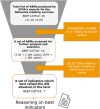Welfare of beef cattle
- PMID: 40718745
- PMCID: PMC12290492
- DOI: 10.2903/j.efsa.2025.9518
Welfare of beef cattle
Abstract
This Scientific Opinion provides an assessment of beef cattle welfare focusing on risks related to flooring, water access, nutrition and feeding, high environmental temperatures, lack of environmental enrichment, lack of outdoor access, minimum space allowance and mixing practices. In addition, risks related to pasture and feedlots, weaning of suckler calves, mutilations (castration, disbudding, dehorning and tail docking), and to breeding practices (hypermuscularity, dystocia and caesarean sections, polledness, maternal ability and temperament) are assessed. Decision-making criteria for the euthanasia of cull cows are also addressed. A selection of animal-based measures (ABMs) suitable for collection at slaughterhouses is proposed to monitor on-farm welfare of fattening cattle. Recommendations to improve the welfare of housed fattening cattle include increasing space allowance and feeding more roughage in relation to current practice, and promoting the use of well-managed bedded solid floors. Provision of enrichment such as brushes and roughage and an outdoor loafing area for housed cattle are recommended. Cattle kept outdoors should have access to a dry lying area and sufficient shade. Water should be provided ad libitum via large open water surfaces, and the use of nipple drinkers should be avoided. Mixing of unfamiliar cattle should be avoided and groups should be kept stable. Mutilations should be abstained from, but if carried out, a combination of analgesia and anaesthesia should be applied regardless of the calf's age. Early weaning of suckler calves should be avoided (< 6 months). Homozygous double-muscled animals should be excluded from breeding. Selected ABMs for collection at slaughterhouses to monitor some of the highly relevant welfare consequences experienced by fattening cattle on farm are body condition, carcass fat levels, carcass condemnation, lung lesions and skin lesions. Key data gaps identified are thresholds for dietary fibre, ABM thresholds for fitness for transport and potential long-term effects of mutilations on pain sensitisation.
Keywords: animal‐based measures; beef cattle; indoor; mutilations; welfare.
© 2025 European Food Safety Authority. EFSA Journal published by Wiley‐VCH GmbH on behalf of European Food Safety Authority.
Figures


























Similar articles
-
[Guidelines for the prevention and management of bronchial asthma (2024 edition)].Zhonghua Jie He He Hu Xi Za Zhi. 2025 Mar 12;48(3):208-248. doi: 10.3760/cma.j.cn112147-20241013-00601. Zhonghua Jie He He Hu Xi Za Zhi. 2025. PMID: 40050074 Chinese.
-
PTS-Related Tetrahydrobiopterin Deficiency (PTPSD).2025 Jul 10. In: Adam MP, Feldman J, Mirzaa GM, Pagon RA, Wallace SE, Amemiya A, editors. GeneReviews® [Internet]. Seattle (WA): University of Washington, Seattle; 1993–2025. 2025 Jul 10. In: Adam MP, Feldman J, Mirzaa GM, Pagon RA, Wallace SE, Amemiya A, editors. GeneReviews® [Internet]. Seattle (WA): University of Washington, Seattle; 1993–2025. PMID: 40638773 Free Books & Documents. Review.
-
Management of urinary stones by experts in stone disease (ESD 2025).Arch Ital Urol Androl. 2025 Jun 30;97(2):14085. doi: 10.4081/aiua.2025.14085. Epub 2025 Jun 30. Arch Ital Urol Androl. 2025. PMID: 40583613 Review.
-
Sexual Harassment and Prevention Training.2024 Mar 29. In: StatPearls [Internet]. Treasure Island (FL): StatPearls Publishing; 2025 Jan–. 2024 Mar 29. In: StatPearls [Internet]. Treasure Island (FL): StatPearls Publishing; 2025 Jan–. PMID: 36508513 Free Books & Documents.
-
Interventions to improve safe and effective medicines use by consumers: an overview of systematic reviews.Cochrane Database Syst Rev. 2014 Apr 29;2014(4):CD007768. doi: 10.1002/14651858.CD007768.pub3. Cochrane Database Syst Rev. 2014. PMID: 24777444 Free PMC article.
References
-
- Absmanner, E. , Rouha‐Mülleder, C. , Scharl, T. , Leisch, F. , & Troxler, J. (2009). Effects of different housing systems on the behaviour of beef bulls—An on‐farm assessment on Austrian farms. Applied Animal Behaviour Science, 118(1–2), 12–19. 10.1016/j.applanim.2009.02.009 - DOI
-
- Adam, M. , Jokela, A. , Salla, K. , Aho, R. , Raekallio, M. , Hänninen, L. , & Hokkanen, A.‐H. (2025). Efficacy of procaine, with and without epinephrine, compared to lidocaine in local Anesthesia for calves before thermocautery disbudding. Journal of Veterinary Pharmacology and Therapeutics, 48(3), 170–179. 10.1111/jvp.13493 - DOI - PMC - PubMed
-
- Adamczyk, K. , Jagusiak, W. , & Makulska, J. (2018). Analysis of lifetime performance and culling reasons in black‐and‐White Holstein‐Friesian cows compared with crossbreds. Annals of Animal Science, 18(4), 1061–1079. 10.2478/aoas-2018-0036 - DOI
-
- Adamczyk, K. , Pokorska, J. , Makulska, J. , Earley, B. , & Mazurek, M. (2013). Genetic analysis and evaluation of behavioural traits in cattle. Livestock Science, 154(1–3), 1–12. 10.1016/j.livsci.2013.01.016 - DOI
LinkOut - more resources
Full Text Sources
